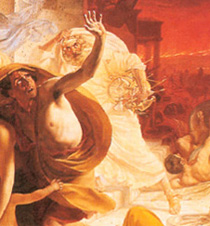 2>
2>Briullov’s 1833 painting The Last Days of Pompeii is primarily a moralistic fantasy with a few factual elements taken from Pliny the Younger’s eyewitness account, mostly concerning bolts of lightening and falling ash. Briullov’s additions are equally spectacular and contrast tales of avarice, greed and selfishness with depictions of love, kindness and self-sacrifice. His most contentious inclusion is the figure of a Christian priest carrying a torch and an incense burner, both sacramental objects symbolising salvation (fig.1). He appears to be attempting to save the afflicted inhabitants, in contrast to the pagan priest who is shown running away from the eruption, concerned only with saving himself and his sack of gold objects (fig.2). Unlike the acclaimed novelist Sir Walter Scott, Lytton did not see and praise the painting in Briullov’s Rome studio, but whilst it was on public display in Milan in 1833. A year later he published The Last Days of Pompeii following a brief visit to the Campanian excavations. Lytton adopted Briullov’s spurious Christian presence and made it the central motif of his book. Its international success subsequently redefined Pompeii by turning a geological disaster into a moral tale concerning God’s retribution heaped upon a hedonistic city. Although relatively few people today will have read his version of The Last days of Pompeii, the novel still continues to exert an influence via numerous film "adaptations", most recently Pompeii (Sony Pictures 2014) and even supposedly historical programmes such as Pompeii : sin city (Sky 2021). The majority of these reflect Lytton’s portrayal of Pompeii as a decadent and violent imitation of the classical Greek world. In so doing they also mislead the viewer into thinking that Roman wall-painting was essentially decorative and therefore devoid of symbolic meaning. In contrast to Briullov’s painting Lytton’s novel takes place within a number of domestic interiors. Only nineteen of the four-hundred and nine pages actually describe the eruption. He invariably uses references to Roman culture and wall-paintings in particular, in order to create a sensual atmosphere designed to underpin one of the book’s main sub-themes, that of Roman decadence.
“The purity of the Pompeians in decoration is, however, questionable: they were fond of the gaudiest colours, of fantastic designs; they often painted the lower half of their columns a bright red, leaving the rest uncoloured; and where the garden was small, its wall was frequently tinted to deceive the eye as to its extent, imitating tree, birds, temples, &c., in perspective – a meretricious delusion which the graceful pedantry of Pliny himself adopted, with a complacent pride in its ingenuity.” (fig.3) [The Last Days of Pompeii, Lytton 1953:37, the edition cited throughout this chapter is the Collins 1953 edition.]
Lytton’s contempt for Roman taste and his veneration of Greek culture surfaces throughout the book. Glaucus, the hero, is of Greek descent. It is worth noting that Lytton's pre-publishing anxieties, as expressed in a letter to his friend the future Prime Minister Benjamin Disraeli, did not involve concerns regarding his crudely expressed critic of Roman aesthetic values, but instead focused upon the “…. fear it won’t please the women. They don’t appreciate artful plots, and artful management.” He need not have worried because both sexes read his book in very large numbers, over 67 editions have been produced so far. (For more on the numerous editions see Laurentino Garcia Y Garcia, Nova Bibliotheca Pompeiana, (250 Anni de Bibliografia Archeologica), 2 vols, Bardi Editori, Roma, 1998). Lytton’s portrayal of Pompeii and Roman taste, then and now distorted popular perceptions of the city, its inhabitants and its visual-culture. His perverse skewing of history was not confined to the numerous editions, Last Days was also adapted into circus events, pyrotechnic displays, stage productions and numerous films (fig.4). These were shown to audiences throughout the world, who avidly consumed them because of their heady mix of passion, intrigue and spectacle.
|